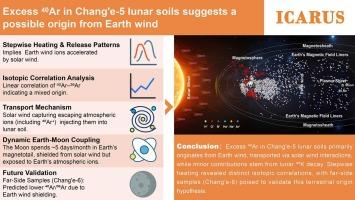Excess 40Ar in Chang'e-5 lunar soils suggests a possible origin from Earth wind
IF 3
2区 物理与天体物理
Q2 ASTRONOMY & ASTROPHYSICS
引用次数: 0
Abstract
The abundance of 40Ar in lunar soils is significantly higher than the expected values from solar wind implantation and 40K decay, a phenomenon known as 40Ar excess. Traditionally, this excess is attributed to 40Ar generated by the decay of 40K within the Moon. This radiogenic 40Ar degasses to the lunar surface, where it is ionized by solar radiation and subsequently captured by lunar soils. However, stepwise heating (200 °C–1300 °C) and degassing analyses of noble gas isotopes in Chang'e-5 lunar soils samples reveal the presence of two types of 40Ar: one unrelated to 36Ar, likely originating from in situ 40K decay in the soils, and another correlated with 36Ar, which may primarily derive from Earth wind. Earth wind, an ion flux formed by the escape of Earth's atmosphere, is thought to be injected onto the lunar surface under the regulation of Earth's magnetosphere. The study proposes that the excess 40Ar in lunar soils may primarily stem from the continuous escape of Earth's atmosphere and be injected onto the lunar surface through both the inner and outer regions of Earth's magnetosphere, offering a new perspective for understanding volatile exchange between the Earth-Moon system.

“嫦娥五号”月球土壤中过量的氩表明,它可能来自地球的风
月球土壤中40Ar的丰度明显高于太阳风注入和40K衰变的期望值,这种现象被称为40Ar过剩。传统上,这种过剩归因于月球内部40K衰变产生的40Ar。这种放射性的氩释放到月球表面,在那里被太阳辐射电离,随后被月球土壤捕获。然而,对嫦娥五号月球土壤样品的逐步加热(200°C - 1300°C)和稀有气体同位素的脱气分析表明,存在两种类型的40Ar:一种与36Ar无关,可能来自土壤中的原位40K衰变,另一种与36Ar相关,可能主要来自地球风。地球风,一种由地球大气层逃逸形成的离子流,被认为是在地球磁层的调节下被注入月球表面的。该研究提出,月球土壤中过量的40Ar可能主要源于地球大气的不断逃逸,并通过地球磁层的内外区域注入月球表面,为理解地月系统之间的挥发交换提供了新的视角。
本文章由计算机程序翻译,如有差异,请以英文原文为准。
求助全文
约1分钟内获得全文
求助全文
来源期刊

Icarus
地学天文-天文与天体物理
CiteScore
6.30
自引率
18.80%
发文量
356
审稿时长
2-4 weeks
期刊介绍:
Icarus is devoted to the publication of original contributions in the field of Solar System studies. Manuscripts reporting the results of new research - observational, experimental, or theoretical - concerning the astronomy, geology, meteorology, physics, chemistry, biology, and other scientific aspects of our Solar System or extrasolar systems are welcome. The journal generally does not publish papers devoted exclusively to the Sun, the Earth, celestial mechanics, meteoritics, or astrophysics. Icarus does not publish papers that provide "improved" versions of Bode''s law, or other numerical relations, without a sound physical basis. Icarus does not publish meeting announcements or general notices. Reviews, historical papers, and manuscripts describing spacecraft instrumentation may be considered, but only with prior approval of the editor. An entire issue of the journal is occasionally devoted to a single subject, usually arising from a conference on the same topic. The language of publication is English. American or British usage is accepted, but not a mixture of these.
 求助内容:
求助内容: 应助结果提醒方式:
应助结果提醒方式:


